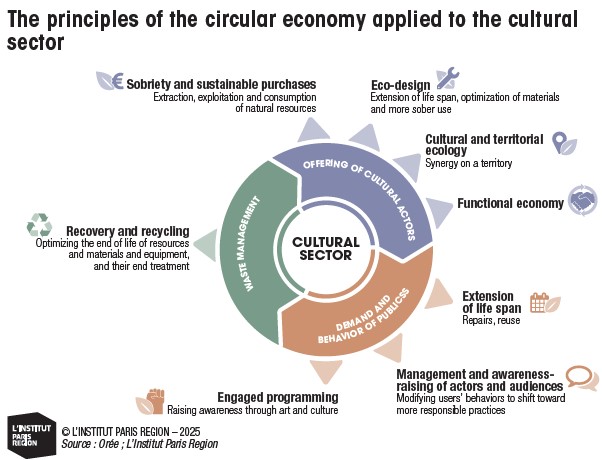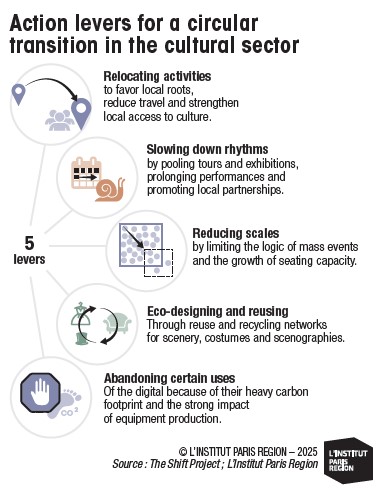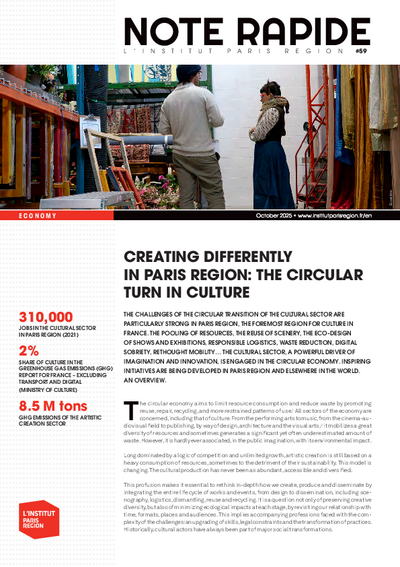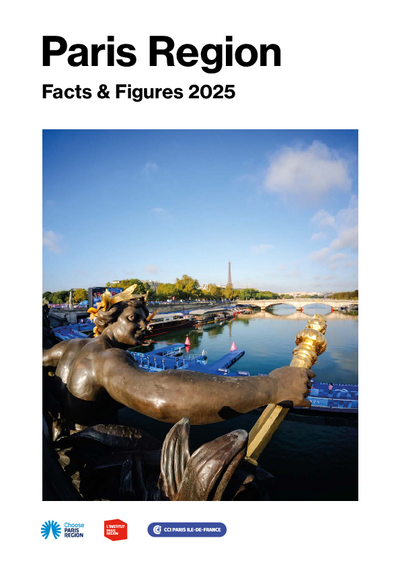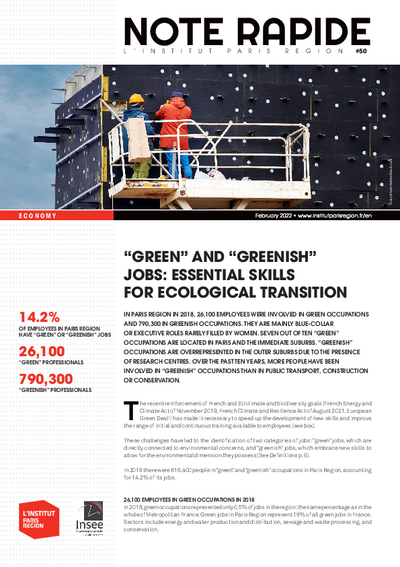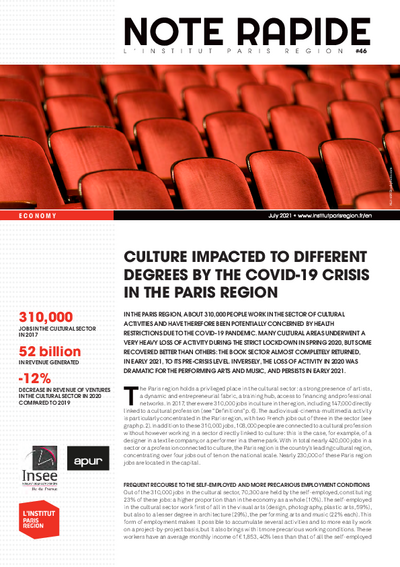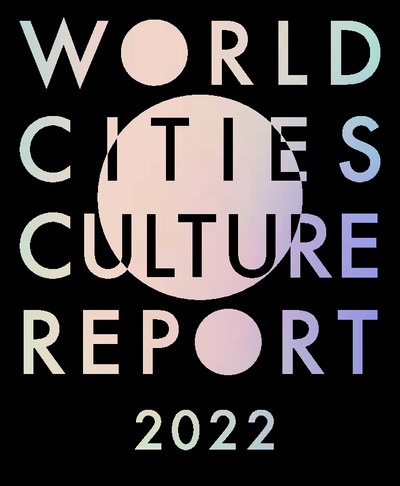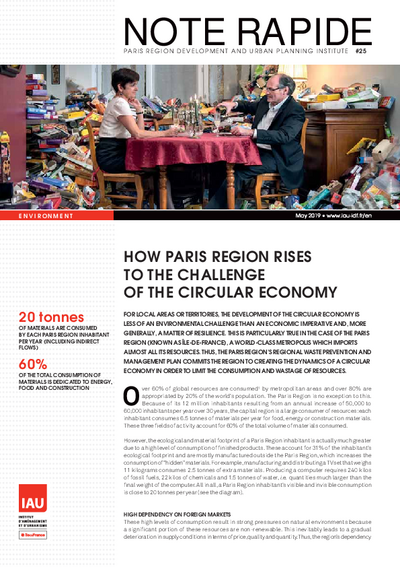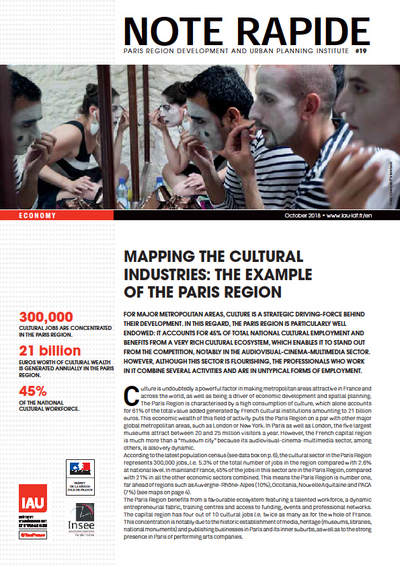Creating differently in Paris Region: the circular turn in culture
The challenges of the circular transition of the cultural sector are particularly strong in Paris Region, the foremost region for culture in France. The pooling of resources, the reuse of scenery, the eco-design of shows and exhibitions, responsible logistics, waste reduction, digital sobriety, rethought mobility… the cultural sector, a powerful driver of imagination and innovation, is engaged in the circular economy. Inspiring initiatives are being developed in Paris Region and elsewhere in the world. An overview.
The circular economy aims to limit resource consumption and reduce waste by promoting reuse, repair, recycling, and more restrained patterns of use.1 All sectors of the economy are concerned, including that of culture. From the performing arts to music, from the cinema-audiovisual field to publishing, by way of design, architecture and the visual arts,2 it mobilizes a great diversity of resources and sometimes generates a significant yet often underestimated amount of waste. However, it is hardly ever associated, in the public imagination, with its environmental impact.
Long dominated by a logic of competition and unlimited growth, artistic creation is still based on a heavy consumption of resources, sometimes to the detriment of their sustainability. This model is changing. The cultural production has never been as abundant, accessible and diversified.
This profusion makes it essential to rethink in-depth how we create, produce and disseminate by integrating the entire life cycle of works and events, from design to dissemination, including scenography, logistics, dismantling, reuse and recycling. It is a question not only of preserving creative diversity, but also of minimizing ecological impacts at each stage, by revisiting our relationship with time, formats, places and audiences. This implies accompanying professions faced with the complexity of the challenges: an upgrading of skills, legal constraints and the transformation of practices. Historically, cultural actors have always been part of major social transformations.
REINVENTING CULTURE THROUGH THE CIRCULAR ECONOMY
In France, as well as elsewhere in the world, the professionals of the cultural sector – actors, technicians, producers – are becoming aware of their ecological footprint and the need to reduce it. The greenhouse gas (GHG) emissions of the artistic creation sector are estimated at 8.5 million tons of CO2 per year.3 The performing arts produce nearly 40,000 tons of waste per year in France (scenery, costumes, technical equipment). The cinema and audiovcoisual sector generated 1.7 million tons of CO2 in 2019. A single feature film shot in France emits about 200 tons of CO2 – equivalent to eight years of emissions from a French household.4 As for museums, the main impact is linked to visitor travel, building operations, and the transport of artworks.
The challenge is particularly acute in Paris Region, a territory with a very dense cultural network. The region has 310 movie theaters, 1,030 libraries, 230 museums, 375 theaters, 450 concert halls and 360 festivals. It accounts for 45% of all cultural jobs in France – 310,000 – representing 6% of the working population in the Paris Region and over 20,000 companies. This dynamic sector closely interacts with other key fields such as transportation, tourism and the digital sector, consequently placing culture at the heart of emerging ecological transitions.
The circular economy is a systemic model that aims at limiting waste production and the consumption of resources while reducing environmental impacts, from the extraction of raw materials to the end of life of products. By favoring sobriety in the use of materials, water and energy, this model also makes it possible to decrease the carbon footprint, because reusing and recycling emit a smaller quantity of GHG than producing something new. Applying these principles to the cultural sector consists in integrating the ecological impact at every stage of the life of a project (design, production, distribution, dissemination) in order to minimize negative impacts as much as possible.
Concretely, this is done through the eco-design of scenery, costumes and signage, through a more efficient energy supply management, through the transformation of organic waste, sorting and optimized logistics of production elements, as well as the elimination of single-use plastics in restaurants and catering.
Three main fields of action structure this approach, adapted to the specific features of the cultural sector (see graph below).
ECO-DESIGN: AT THE HEART OF THE CULTURAL TRANSITION
Support policies are emerging, such as Circul’Art, initiated by Film Paris Region, to promote good eco-design practices for scenery and waste management, in close collaboration with professionals. In cinema, efforts focused on the main budget items responsible for the highest GHG emissions: transport, scenery and energy. The company Les Films du Fleuve consequently set up an eco-production approach on Jeunes Mères, by the Dardenne brothers, which received the Ecoprod prize in Cannes, in 2025. The shooting, concentrated on the same place, made it possible to reduce travel, energy and waste. The sets were designed for reuse and the props given to a daycare center and the Maison maternelle, an association.
In the performing arts, the logistics of overproduction and unsustainable tours exacerbate environmental and social impacts. The Théâtre de l’Aquarium is working on reducing these effects via eco-design, the recycling of stage sets and the development of an eco-responsible network in Paris Region.
REUSE AND CREATION: A NEW MOMENTUM
Reuse is an essential driver of circular models, largely influenced by the choice of service providers. Paris Musées integrates a reuse logic in the design of its temporary exhibitions.
Inspiring initiatives are emerging, such as the Réserve des arts, the first cultural recycling center in France, which accompanies professionals in the eco-design and reuse of materials for artistic productions and events. Another example is the RESSAC network, that collects, each year, about 2,000 tons of materials, of which 70% are reinjected into the production chain. The actors of the social and solidarity economy (SSE) are organized to provide a model based on sobriety, local distribution networks, solidarity and awareness-raising on changes in behavior.
Fashion and fine crafts, through their focus to materials and practices such as reuse, recycling and upcycling,5 illustrate this circular logic, drawing on local and ecological resources like certified timber, vegetable dyes, local clays and recycled textiles.
ENERGY SUPPLY: A CHALLENGE FOR CULTURAL VENUES
The circular economy requires more efficient management of cultural buildings, with increased vigilance on resource consumption. Confronted with the rise in energy prices, a collective of four independent cultural venues in Seine-Saint-Denis (Le 6B, Mains d’Œuvres, the Villa Mais d’ici and Les Poussières) launched Green Kommon. The aim of this project is to produce solar energy by equipping their spaces with photovoltaic panels. It is part of a model of collective self-consumption for their own use and plans for the creation of a cultural energy fund to support local artistic initiatives while decreasing the venues’ energy bill.
In the events sector, many major sports (the Olympic and Paralympic Games, for example) or cultural events (the Rock en Seine music festival) turn to alternatives to diesel generators (batteries or hydrogen) or are connected to the public electricity grid (to benefit from low-carbon electricity).
TOWARD A ZERO-WASTE CULTURE?
In the cinema-audiovisual sector, aid from the Centre national du cinema (CNC) is now subject to an eco-conditions: productions must provide a double carbon report, one projected and one final. This requirement aims at encouraging more sustainable practices, notably on waste management and recycling. To accompany this transition, the SME Fin de déchets directly intervenes on shooting locations to collect and manage waste, consequently facilitating the implementation of practical and responsible solutions.
Sectors like publishing have also started to institute a transition: if the use of certified paper is now commonplace, the challenge remains significant regarding waste and the reduction of unsold publications, as the involvement of certain publishing companies shows, like Rue de l’Échiquier, in Paris, with local printing and sustainable paper, gifts to solidarity structures (Emmaüs, for example) as well as a committed editorial stance.
THE EMERGENCE OF NEW PROFESSIONS
The ecological transition of the cultural sector has created new professions and is transforming expected competencies. Positions such as head of CSR, cultural eco-consultant, eco-production representative, waste management consultant and renewable energy manager are developing, highlighting the need to strengthen training opportunities.
At the same time, new support structures have emerged in Paris Region to support this transformation. The ARVIVA association acts for more sustainable performing arts, by providing professionals with tools (environmental report, observatory, promotion of initiatives) and advocating for a fairer model for the sector. Les Augures association supports cultural actors in their ecological redirection, by mobilizing artistic communities on adaptation and innovation. Lastly, the 104 Factory, the incubator of cultural and creative industries of the Centquatre-Paris, with its “Culture Impact” program, explores innovative solutions and practices to reduce culture’s ecological footprint through an urban laboratory dedicated to transition.
RECONCILING PROTECTION OF HERITAGE AND ECOLOGICAL TRANSITION
With over 4,000 historic monuments, five sites inscribed at UNESCO and 230 museums, the heritage of the Paris Region is dense. To meet ecological challenges, conservation practices are evolving: use of less harmful preservation products and techniques, review of lending protocols and the transport of works, prioritization of restoration operations… The building of the Archives nationales in Saint-Denis, for example, illustrates these good practices. Its architectural design preserved as many trees as possible and expanded planted areas, with a diverse range of plant species. Well-insulated, it is supplied by urban heating (geothermal energy, wood, gas/biogas).
DEVELOPING A CULTURE OF DIGITAL SOBRIETY
Closely linked to digital technologies, culture is the leading sector worldwide in online data consumption,6 generating 4.4% of national GHG emissions.7 In France, in 2020, there were over 631 million digital devices, or 11 per user,8 illustrating the scope of the challenge. The ecological transition of the cultural sector requires digital sobriety at every stage: creation, dissemination, conservation, archiving.9 Beyond the 2021 REEN (Reduction of Environmental and Digital Footprint) law, tailored strategies must be developed. Initiatives like Qarnot Computing, which recycles the servers’ heat, point the way forward. Limiting energy consumption and extending the life span of equipment are essential.
RETHINKING AUDIENCE MOBILITY FOR A CULTURE THAT REMAINS ACCESSIBLE
The mobility of audiences is the principal source of GHG emissions of the cultural sector: it accounts for 45% of theaters’ carbon footprint, up to 75% for festivals, 90% for movie theaters, and even 99% for a museum such as the Louvre.10 To meet this challenge, the question is one of promoting sustainable mobility practices: local anchoring with a nearby cultural offer, traveling shows, coordinated tours or exhibitions outdoors. Adapting public transportation schedules to cultural time slots is a key tool, requiring cooperation between cultural stakeholders, communities, and funders.11 Raising the public’s awareness is also vital, as has been shown by the festival We Love Green, which provides information and offers “eco-mobile” solutions.
CULTURAL CIRCULARITY: BETWEEN THE POWER OF IMAGINATION AND MARKET TRANSFORMATION
Artists, and their capacity to mobilize the imagination and to involve publics in shared narratives, play a critical role in the circular transition of the cultural sector. By providing meaning and encouraging engagement, they help forge new collective performances capable of supporting transformations. At the same time, adopting circular practices becomes a strategic imperative for the creative industries: what was once a matter of proactive engagement is becoming a prerequisite for market access, as the growing requirements of streaming platforms illustrate. Circularity thus emerges both as a symbolic horizon and as a structuring driver of market access.■
1. The circular economy breaks with the classic linear model (“extract, produce, consume, throw away”) to adopt strategies that aim at extending the life span of products and recycling resources in closed loops. According to the ADEME, the French Agency for Ecological Transition, it is based on seven essential pillars: a sustainable supply, eco-design, industrial and territorial ecology, the functional economy, responsible consumption, the prolongation of the duration of use (by reuse, repairs…) and recycling.
2. The economic field of culture was established by the statistics department of the Ministry of Culture, using a European definition. Cultural, artistic and creative activities, grouped under the term “cultural and creative industries,” is organized around eight major fields: visual arts, performing arts, cinema-audiovisual, publishing (books and the press), heritage, amateur artistic education, architecture and advertising. Design, fashion and fine crafts are also added to this list, although these fields are not taken into account in public statistics.
3. “Étude sur le bilan carbone de la création artistique,” Ministry of Culture, July 2025.
4. Film Paris Region.
5. Upcycling is a creative practice that promotes a circular and ecological mode through the recuperation of clothing, fabric scraps, curtains or any other textile that is not or no longer used, to give them a new life.
6. “Décarbonons la culture !,” The Shift Project, November 2021.
7. Ecological Transition in Culture, guidance and inspiration document, Ministry of Culture, December 2023.
8. “Impacts environnementaux du numérique en France,” greenit.fr, 2020.
9. “Déployer la sobriété numérique,” The Shift Project, 2020.
10. “Quel impact carbone pour les lieux et les festivals de jazz ?,” Périscope-Footprints, Association Jazzé Croisé (AJC).
11. “La mutation écologique du spectacle vivant. Des défis, une volonté,” Syndeac, March 2023.
CULTURAL AND CIRCULAR ECONOMY POLICIES IN PARIS REGION
Public policies play a major role in bringing together and supporting cultural actors in the ecological transition, notably through awareness-raising and training. In Paris Region, the Stratégie régionale d’économie circulaire (Srec), adopted in 2020, integrates culture into its actions: support for actors, support for specialized reuse and recycling centers and incentives like the “ecological bonus” for engaged audiovisual productions. On the national scale, with “Alternatives vertes 2” invitations to tender, France 2030 is financing innovative projects that favor the ecological transition in all cultural fields. The goal is to generalize the measurement of environmental impacts, develop tailored tools and strengthen the training of professionals to accelerate this sustainable transformation.
This study is linked to the following theme :
Economy
